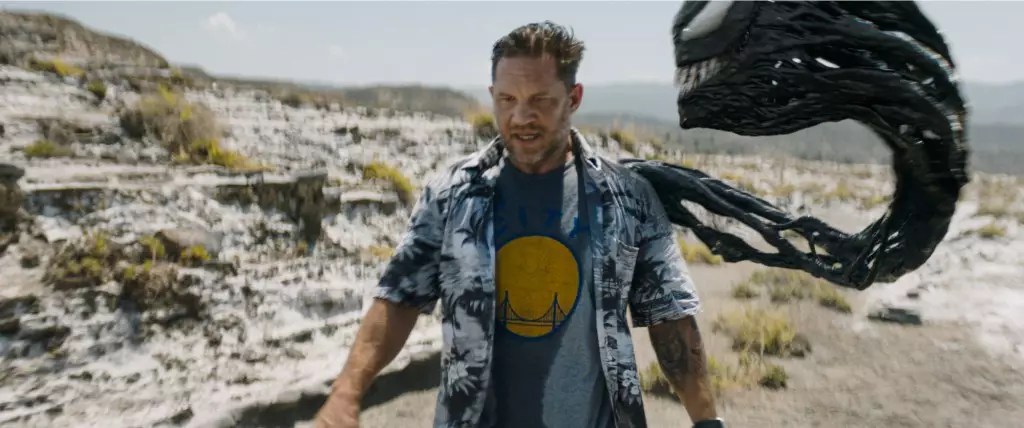In a curious twist of casting fate, the third installment of Marvel’s Venom saga, titled “Venom: The Last Dance,” features a predominantly British ensemble portraying American characters. This quirk raises questions about the film’s authenticity in terms of cultural representation, yet it reflects a broader trend in Hollywood where talent often overrides geographical origins. Leading the charge is Tom Hardy, who reprises his role as Eddie Brock, the investigative journalist intertwined with the titular symbiotic entity. The supporting cast includes notable actors such as Chiwetel Ejiofor, Juno Temple, Rhys Ifans, and Stephen Graham, all of whom contribute to a solid foundation, even if their accents occasionally betray their roots. The film ultimately showcases the influences of British theater on American cinema, offering a unique lens through which audiences can experience superhero narratives.
Despite the star power and engaging performances, “The Last Dance” grapples with a rather familiar dilemma — justifying its own existence in an oversaturated superhero landscape. Mirroring the struggles of films like Sam Raimi’s “Spider-Man 3,” it becomes evident that the weight of expectations can bloat even the most promising franchises. Marvel has continuously pushed the boundaries with risks; however, this latest installment illustrates a franchise that is perhaps resting on its laurels, relying on its established brand rather than fresh creativity. The film invites viewers back into its world without providing adequate context for newcomers, assuming a prior investment in Brock’s saga. This decision propels the story into a chaotic launch sequence steeped in the series’ mythology but alienates those who may not be well-versed in its intricacies.
The film opens in a foreboding prison planet, where Knull, played by Andy Serkis, reigns ominously over a cadre of insect-like creatures. This initial scene sets the tone of impending doom with Knull’s ambitions to reshape the universe, thus ensuring a classic good-versus-evil showdown. Additionally, the bleak atmosphere serves as an effective narrative device, plunging audiences into a world where danger lurks at every corner. However, the quick-cut storytelling that follows — jumping between Brock’s misadventures in Mexico and Knull’s machinations — risks losing the audience’s engagement. In an era when audiences demand depth and coherent narratives, this fractured storytelling may lead many to disengage before they even grasp the stakes involved.
While the film struggles under the weight of its labyrinthine plot, it does excel in moments of humor, particularly through Brock’s interactions with Venom, his symbiotic partner. The duo provides comedic relief amid chaotic chases and battles, channeling the witty banter reminiscent of the “Deadpool” franchise that previously breathed new life into the superhero genre. These humorous exchanges — such as Brock’s struggles with a hangover or Venom’s flamboyant escapades in Las Vegas — offer a refreshing counterbalance to the darker elements of the story. Still, one must question whether these fleeting comedic moments are sufficient to anchor a narrative that, at its core, feels disjointed.
As the film progresses, it becomes evident that many Marvel movies now adhere to a well-trodden formula: a race against time to secure a vital plot device—a codex in this case—often leading to an explosive climax. This pattern, while providing comfort for returning fans, also limits the scope for innovation, risking fatigue in an audience eager for groundbreaking narratives. The inevitable climactic battle, integrating humans, xenophages, and symbiotes, unfolds with clarity thanks to director Kelly Marcel’s focused approach, reminiscent of Ang Lee’s artistic interpretation in “Hulk.” However, it ultimately begs for depth, both in character development and thematic exploration.
“Venom: The Last Dance” closes a chapter in Brock’s journey while provocatively leaving the door ajar for future sequels or spin-offs. Though it may not ascend to the heights of its predecessors, the film still manages to entertain, albeit inconsistently. In a market flooded with superhero films, it’s crucial for franchises like Venom to cultivate an inventive spirit that pushes narratives beyond mere spectacle. While the film may falter in parts, its attempt to wrap up an intricate tale provides a sense of closure — albeit one that feels somewhat perfunctory. Ultimately, as audiences continue to navigate the crowded superhero landscape, it remains vital for filmmakers to deliver narratives that challenge norms, spark curiosity, and evolve beyond the familiar formulas of cinematic superheroism.


Leave a Reply